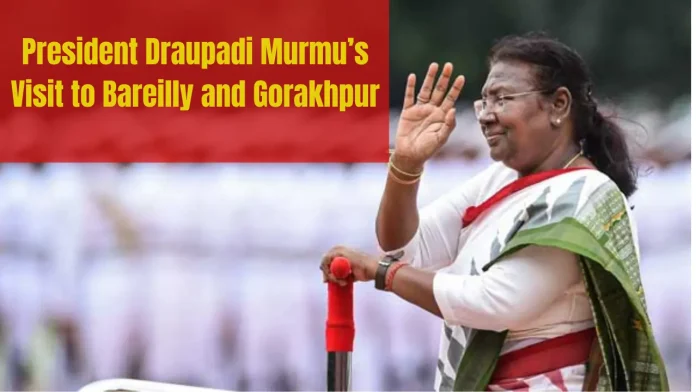On June 30, 2025, President Draupadi Murmu, India’s first tribal woman President, will embark on a significant visit to Uttar Pradesh, gracing the cities of Bareilly and Gorakhpur with her presence.
Her brief yet impactful visit to Bareilly, lasting one hour and forty minutes, will be followed by a journey to Gorakhpur, where she will engage in key events, including the inauguration of academic and healthcare facilities.
This visit underscores her commitment to education, tribal welfare, and the upliftment of marginalized communities, aligning with her illustrious career as a public servant.
Below is a detailed account of her itinerary, the significance of her visit, and the broader context of her contributions to Indian society.
President Murmu’s Itinerary in Bareilly
President Draupadi Murmu will arrive in Bareilly on June 30, 2025, to attend the 11th convocation ceremony of the Indian Veterinary Research Institute (IVRI) as the chief guest.
The event, held at the Swami Vivekanand Auditorium, will see the President awarding degrees and PhDs to 576 students, with 65 receiving special recognition for their academic excellence.
Her visit to Bareilly is tightly scheduled, with her stay limited to one hour and forty minutes, reflecting the precision and efficiency of her engagements.
Table 1: President Murmu’s Schedule in Bareilly
| Time | Activity |
|---|---|
| 10:00 AM – 10:10 AM | Arrival at Bareilly Airport |
| 10:15 AM – 11:35 AM | Attend IVRI 11th Convocation Ceremony, Award Degrees and Medals |
| 11:40 AM | Departure for Gorakhpur |
The convocation at IVRI is a significant event, as the institute is one of India’s premier research organizations, contributing to animal health and veterinary sciences.
IVRI has developed 40 vaccines, 20 of which are indigenous, and has played a pivotal role in eradicating four major animal diseases, including Rinderpest.
The institute’s National Animal Disease Control Program, operational since 2019, has generated significant revenue (₹20 crore) through technology transfers to 160 commercial entities.
President Murmu’s presence at this event highlights the importance of scientific advancements in agriculture and animal husbandry, sectors critical to India’s rural economy.
Transition to Gorakhpur
Following her brief stop in Bareilly, President Murmu will travel to Gorakhpur, where she will participate in the inauguration of several facilities at the Mahayogi Gorakhnath University and attend an event at the All India Institute of Medical Sciences (AIIMS).
Her visit to Gorakhpur includes a night stay, emphasizing the city’s growing importance as a hub for education and healthcare in eastern Uttar Pradesh.
In Gorakhpur, the President will inaugurate an academic building, a 1,500-capacity auditorium, a world-class Panchakarma center with 11 cottages, and lay the foundation stone for a 1,000-capacity girls’ hostel at Mahayogi Gorakhnath University.
These developments reflect the university’s rapid growth since its establishment in 2021, earning recognition for its employment-oriented education and integration of modern and traditional medical practices.
Table 2: President Murmu’s Schedule in Gorakhpur
| Time | Activity |
|---|---|
| 12:30 PM | Arrival at Gorakhpur Airport |
| 1:00 PM – 2:30 PM | Attend event at AIIMS Gorakhpur |
| 3:00 PM – 5:00 PM | Inaugurate facilities at Mahayogi Gorakhnath University |
| Evening | Night stay in Gorakhpur |
| July 1, 2025 | Additional engagements (to be confirmed) |
The AIIMS event underscores the government’s focus on enhancing healthcare infrastructure in Uttar Pradesh, particularly in underserved regions.
President Murmu’s participation highlights her advocacy for accessible healthcare and education, aligning with her broader mission to empower marginalized communities.
Security and Administrative Arrangements
The President’s visit has prompted extensive security and administrative preparations in both cities.
In Bareilly, a high-level meeting chaired by District Magistrate Avinash Singh ensured meticulous planning, with directives issued to the municipal corporation, electricity department, public works department, and police to maintain flawless arrangements.
The presence of Uttar Pradesh Chief Minister Yogi Adityanath and Governor Anandiben Patel during the IVRI convocation further elevates the event’s significance, necessitating robust coordination among departments.
In Gorakhpur, security measures are equally stringent, with five large drones deployed to monitor the President’s travel route, covering 31 kilometers by road.
The security detail includes 8 Superintendents of Police, 13 Additional Superintendents of Police, 35 Circle Officers, 35 Station House Officers, 70 Inspectors, 442 Sub-Inspectors, 2,455 Head Constables, 40 women Sub-Inspectors, 220 women Constables, 13 Traffic Inspectors, 50 Traffic Sub-Inspectors, 145 Traffic Head Constables, 263 Traffic Constables, two companies of the Provincial Armed Constabulary (PAC), two Anti-Terrorist Squad (ATS) teams, and personnel from the Local Intelligence Unit (LIU).
This comprehensive deployment ensures the safety of the President and dignitaries while maintaining public order.
Table 3: Security Deployment in Gorakhpur
| Personnel Type | Number Deployed |
|---|---|
| Superintendents of Police | 8 |
| Additional Superintendents of Police | 13 |
| Circle Officers | 35 |
| Station House Officers | Station House Officers |
| Inspectors | 70 |
| Sub-Inspectors | 442 |
| Head Constables | 2,455 |
| Women Sub-Inspectors | 40 |
| Women Constables | 220 |
| Traffic Inspectors | 13 |
| Traffic Sub-Inspectors | 50 |
| Traffic Head Constables | 145 |
| Traffic Constables | 263 |
| PAC Companies | 2 |
| ATS Teams | 2 |
| LIU Personnel | 149 |
These arrangements reflect the high priority given to the President’s safety and the smooth execution of her visit, ensuring minimal disruption to public life while maintaining protocol.
Significance of President Murmu’s Visit
President Draupadi Murmu’s visit to Bareilly and Gorakhpur is more than a ceremonial engagement; it is a testament to her enduring commitment to education, healthcare, and tribal welfare.
As the first tribal woman to hold India’s highest office, her presence at these events carries symbolic weight, particularly in Uttar Pradesh, a state with a significant tribal population.
Her journey from a remote village in Odisha’s Mayurbhanj district to the Rashtrapati Bhavan is a powerful narrative of resilience and determination, inspiring millions across the country.
Educational Impact
The convocation at IVRI and the inaugurations at Mahayogi Gorakhnath University highlight the critical role of education in nation-building.
IVRI’s contributions to veterinary sciences and Mahayogi Gorakhnath University’s focus on employment-oriented education align with India’s vision of self-reliance (Atmanirbhar Bharat).
President Murmu’s participation underscores the importance of empowering youth through quality education and research, particularly in fields that directly impact rural livelihoods.
Healthcare Advancements
The event at AIIMS Gorakhpur reflects the government’s commitment to strengthening healthcare infrastructure in eastern Uttar Pradesh, a region historically underserved in medical facilities.
The inauguration of the Panchakarma center at Mahayogi Gorakhnath University further emphasizes the integration of traditional Ayurvedic practices with modern medicine, a cause close to President Murmu’s heart given her advocacy for holistic development.
Tribal Welfare and Representation
As a member of the Santhal tribal community, President Murmu’s visit resonates deeply with tribal populations in Uttar Pradesh and beyond.
Her tenure as Governor of Jharkhand (2015-2021) was marked by efforts to protect tribal land rights and promote education among tribal communities.
Her presence in Gorakhpur, a region with a notable tribal population, reinforces her role as a champion of marginalized groups, encouraging inclusive development.
President Murmu’s Legacy
Born on June 20, 1958, in Uparbeda village, Odisha, Draupadi Murmu’s journey is one of overcoming adversity.
Despite growing up in poverty, she became the first woman from her village to earn a Bachelor of Arts degree from Rama Devi Women’s College, Bhubaneswar.
Her career began as a junior assistant in Odisha’s Irrigation and Power Department, followed by a stint as a teacher. Entering politics in 1997 with the Bharatiya Janata Party (BJP), she served as a councillor, MLA, and Minister of State in Odisha before becoming Jharkhand’s first woman Governor.
Her presidency, which began on July 25, 2022, has been marked by a focus on social justice, women’s empowerment, and tribal welfare.
Her visits to various states and international engagements have strengthened India’s global and domestic outreach, particularly in connecting with the Indian diaspora.
Her personal tragedies, including the loss of her husband and two sons, have shaped her resilience, with meditation and spirituality playing a significant role in her coping mechanism.
Table 4: Key Milestones in President Murmu’s Career
| Year | Achievement |
|---|---|
| 1997 | Elected as Councillor, Rairangpur Nagar Panchayat |
| 2000-2009 | Served as MLA, Rairangpur Constituency, Odisha |
| 2000-2004 | Minister of State, Commerce & Transport, Fisheries & Animal Resources, Odisha |
| 2007 | Received Nilkantha Award for Best MLA, Odisha Legislative Assembly |
| 2015-2021 | Served as Governor of Jharkhand, first woman and tribal leader in the role |
| 2022 | Elected as 15th President of India, first tribal woman and youngest President |
President Draupadi Murmu’s visit to Bareilly and Gorakhpur on June 30, 2025, is a landmark event for Uttar Pradesh, highlighting the state’s progress in education and healthcare.
Her participation in the IVRI convocation and the inauguration of facilities at Mahayogi Gorakhnath University and AIIMS Gorakhpur underscores her commitment to empowering youth, advancing scientific research, and promoting inclusive development.
The meticulous security and administrative arrangements reflect the significance of her visit, while her personal journey continues to inspire millions.
As India’s first tribal woman President, Draupadi Murmu’s presence in these cities is a powerful reminder of the transformative potential of resilience, education, and public service.

